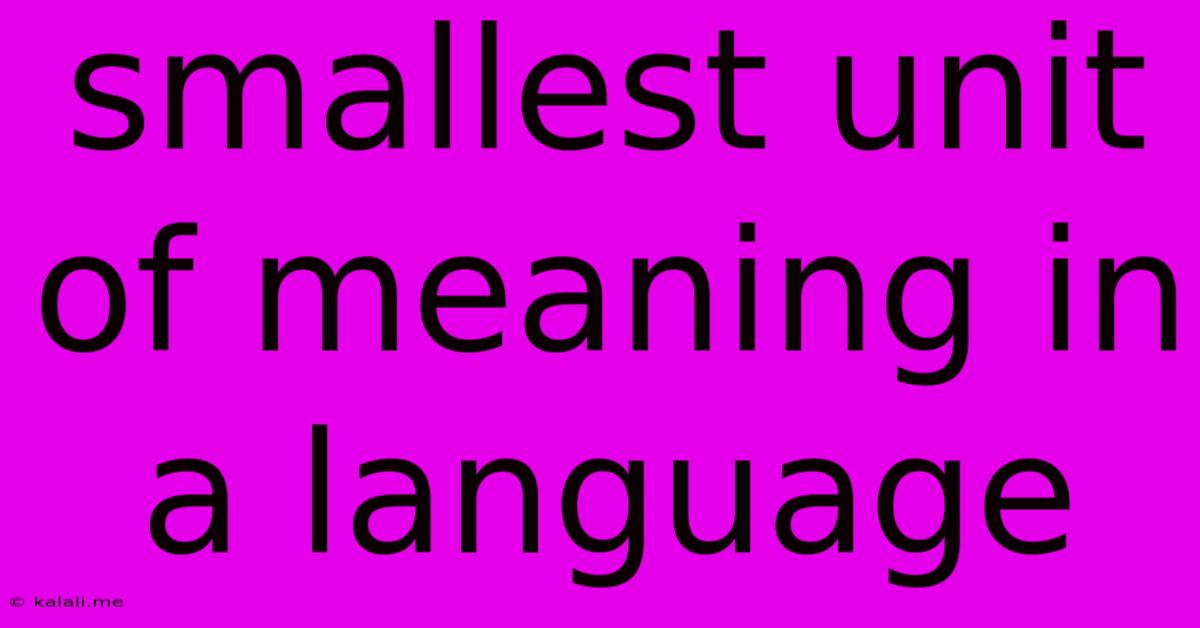Smallest Unit Of Meaning In A Language
Kalali
Jun 13, 2025 · 3 min read

Table of Contents
The Smallest Unit of Meaning: Understanding Morphemes in Linguistics
Have you ever wondered what the fundamental building blocks of language are? Beyond letters and sounds, lies the fascinating concept of the morpheme, the smallest unit of meaning in a language. This article delves into the world of morphemes, exploring their different types and significance in linguistic analysis. Understanding morphemes is crucial for anyone interested in language structure, vocabulary development, and even computational linguistics.
Morphemes are the indivisible units of meaning that contribute to word formation. Unlike sounds (phonemes), which are the smallest units of sound, morphemes represent the smallest units of meaning. They can be entire words or just parts of words, and their combination creates the vast lexicon of any given language.
Types of Morphemes: A Closer Look
Morphemes are broadly classified into two main categories:
1. Free Morphemes: These are morphemes that can stand alone as independent words. They carry meaning on their own and don't require any other morpheme to be meaningful. Examples include words like cat, dog, run, and happy. These are the fundamental building blocks of our vocabulary. They often form the core of a word, contributing its main semantic meaning.
2. Bound Morphemes: Unlike free morphemes, bound morphemes cannot stand alone. They must be attached to other morphemes (free or bound) to have meaning. They are typically prefixes or suffixes, but can also be infixes (inserted within a word) or circumfixes (surrounding a word).
- Prefixes: These are bound morphemes attached to the beginning of a word. Examples include un- (unhappy), re- (rewrite), and pre- (pregame). They often modify the meaning of the root word.
- Suffixes: These are bound morphemes added to the end of a word. Examples include -ing (running), -ed (played), and -ly (quickly). Suffixes frequently indicate grammatical function, such as tense or plurality.
- Infixes: These are relatively rare and found in fewer languages. They are inserted within a word, often changing the meaning or tense.
- Circumfixes: These morphemes surround the root morpheme.
Morpheme Analysis: Breaking Down Words
Analyzing words into their constituent morphemes is a valuable skill in linguistics. This process, known as morphological analysis, helps us understand how words are formed and how meaning is created. For instance, let's consider the word "unbreakable":
- un-: A prefix meaning "not" or "opposite of".
- break: A free morpheme meaning "to separate into pieces".
- -able: A suffix meaning "capable of being".
Therefore, "unbreakable" means "not capable of being broken". This breakdown illustrates how morphemes combine to create complex meanings.
The Importance of Morphemes
Understanding morphemes is essential for various aspects of linguistics and language study:
- Vocabulary Acquisition: Knowing how morphemes combine helps learners understand and remember new words more effectively.
- Lexical Development: Morphemes play a significant role in the growth and evolution of language's lexicon.
- Computational Linguistics: Morpheme analysis is vital in Natural Language Processing (NLP) for tasks like machine translation and text analysis.
- Comparative Linguistics: Comparing the morphemes across different languages sheds light on language relationships and historical development.
In conclusion, the morpheme, the smallest unit of meaning, is a fundamental concept in linguistics. By understanding the different types of morphemes and how they combine to create words, we gain a deeper appreciation for the complexity and beauty of human language. Further exploration into morphology will undoubtedly enrich your understanding of language structure and function.
Latest Posts
Latest Posts
-
Which Of The Following Is An Example Of Reduction
Jun 14, 2025
-
Difference Between Small Scale And Large Scale
Jun 14, 2025
-
1 Hp Is Equal To How Many Watts
Jun 14, 2025
-
All Of The Following Are Primary Air Pollutants Except
Jun 14, 2025
-
Why Do People Go To Weekly Market
Jun 14, 2025
Related Post
Thank you for visiting our website which covers about Smallest Unit Of Meaning In A Language . We hope the information provided has been useful to you. Feel free to contact us if you have any questions or need further assistance. See you next time and don't miss to bookmark.